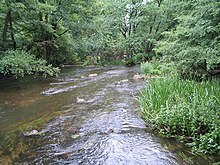Sternberg district
The Sternberg district was a district in the Schwerin district in the GDR . From May 17, 1990, it continued as the district of Sternberg . Today his area belongs to the districts of Ludwigslust-Parchim and Northwest Mecklenburg in Mecklenburg-Western Pomerania . The seat of the district administration was in Sternberg .
geography
location
The district comprised a large part of the area now known as the Sternberger Seenlandschaft . The landscape was characterized by lakes, forests (a quarter of the district area) and hills (up to 83 m above sea level ) as well as the two rivers Warnow and Mildenitz . The larger lakes in the Sternberg district included the Great Wariner See , the Gross Labenzer See , the Great Sternberger See and the Kleinpritzer See .
Area and population
The area of the district was 493 km². this corresponded to 5.7% of the area of the Schwerin district.
The population was around 23,300 in 1985. That was 3.9% of the residents of the district. The population density was 47 inhabitants per km².
Neighboring areas
The smallest county in the district of Schwerin, which concerned the space and the number of inhabitants, bordered on the northwest by the county Wismar , the west and southwest to the county Schwerin-Land , on the south by the county Parchim , in the southeast on the circle Lübz , to the east to the district of Güstrow and in the north to the district of Bützow .
history
The Mecklenburg district of Sternberg was created when the federal states were dissolved on July 25, 1952 from the southeastern part of the old district of Wismar and belonged to the newly formed district of Schwerin. The district came to the newly founded state of Mecklenburg-Western Pomerania on October 3, 1990 within the accession area to the Federal Republic of Germany . On June 12, 1994 the district (since May 17, 1990 referred to as the district) was dissolved and divided: the majority fell to the Parchim district , the five communities Bibow, Groß Labenz, Jesendorf, Ventschow and Warin came to the newly founded district Northwest Mecklenburg .
Economy and Infrastructure
Agriculture and forestry played the main role in the Sternberg district, while tourism was of secondary importance. Large farms were located in Warin and Sternberg, industrial animal production in Wilhelmshof and Kobrow (pig fattening), in Borkow and Kuhlen (cattle fattening) and in Warin (fish farming). There were wood processing companies in Dabel and Sternberg. The building materials industry in Blankenberg and Ventschow used the nearby gravel and clay deposits.
Dabel was an NVA site (including 5th artillery regiment).
The main traffic axes in the district were the F 104 and the F 192 , which connected the district with the surrounding larger cities. The main railway line Schwerin-Rostock crossed the district in the north, in Blankenberg the branch line crossed from Wismar via Warin, Brüel and Sternberg to Goldberg .
photos
Town hall in Brüel
cities and communes
On October 3, 1990, the district of Sternberg had 21 municipalities, including three cities:
|
License Plate
Motor vehicles (with the exception of motorcycles) and trailers were assigned three-letter distinctive signs from around 1974 to the end of 1990, beginning with the pair of letters BU . The last number plate series used for motorcycles was BT 77-01 to BT 90-00 .
At the beginning of 1991 the district received the distinctive sign STB . It was issued until June 11, 1994. It has been available in the Ludwigslust-Parchim district since August 1, 2013 . ( License plate liberalization )
Individual evidence
- ↑ a b Federal Statistical Office (ed.): Municipalities 1994 and their changes since 01.01.1948 in the new federal states . Metzler-Poeschel, Stuttgart 1995, ISBN 3-8246-0321-7 .
- ↑ Law on the self-administration of municipalities and districts in the GDR (municipal constitution) of May 17, 1990
- ↑ Andreas Herzfeld: The history of the German license plate . 4th edition. German Flag Society V., Berlin 2010, ISBN 978-3-935131-11-7 , pp. 301 .
- ↑ Andreas Herzfeld: The history of the German license plate . 4th edition. German Flag Society V., Berlin 2010, ISBN 978-3-935131-11-7 , pp. 551 .





